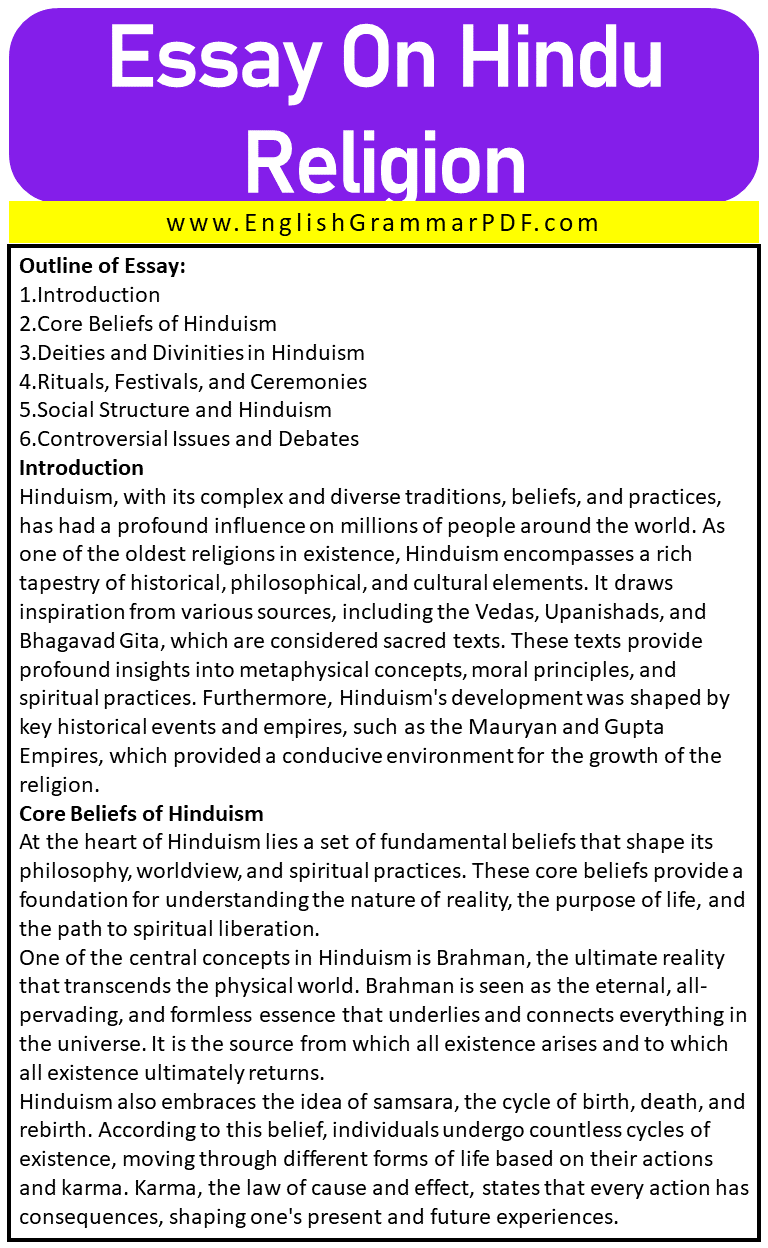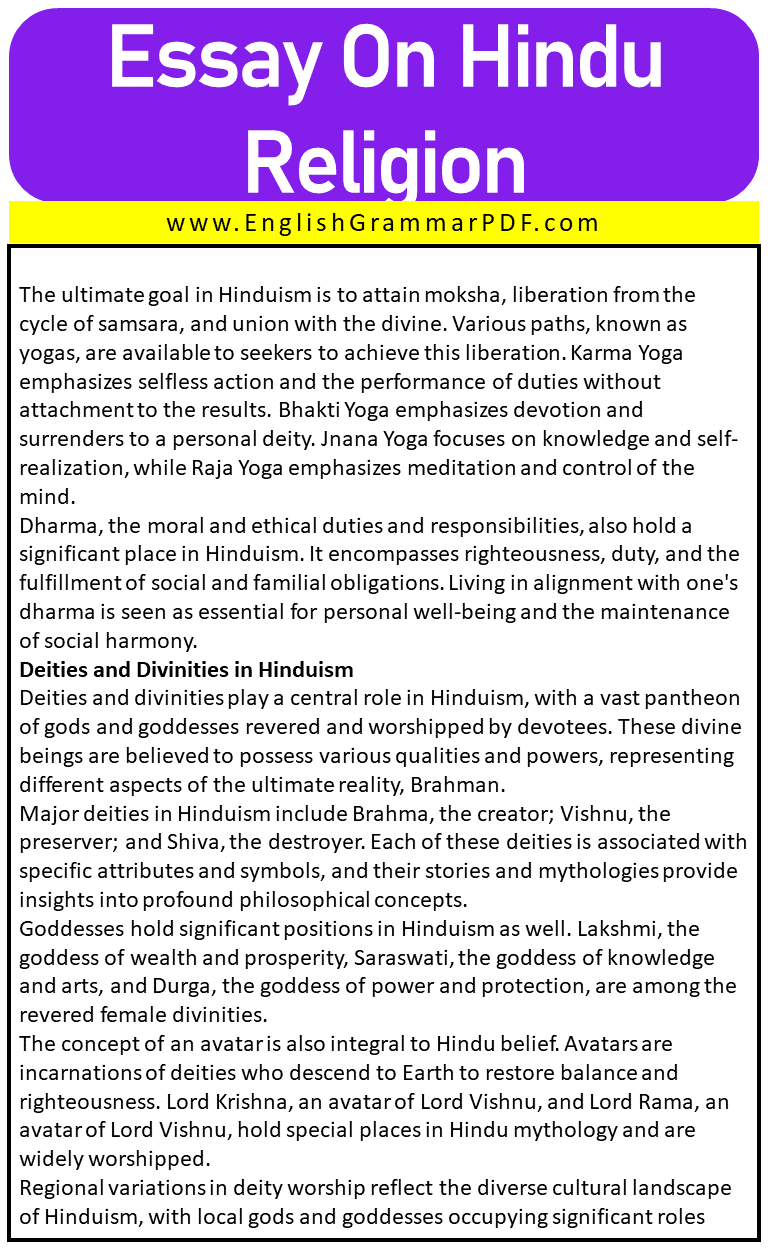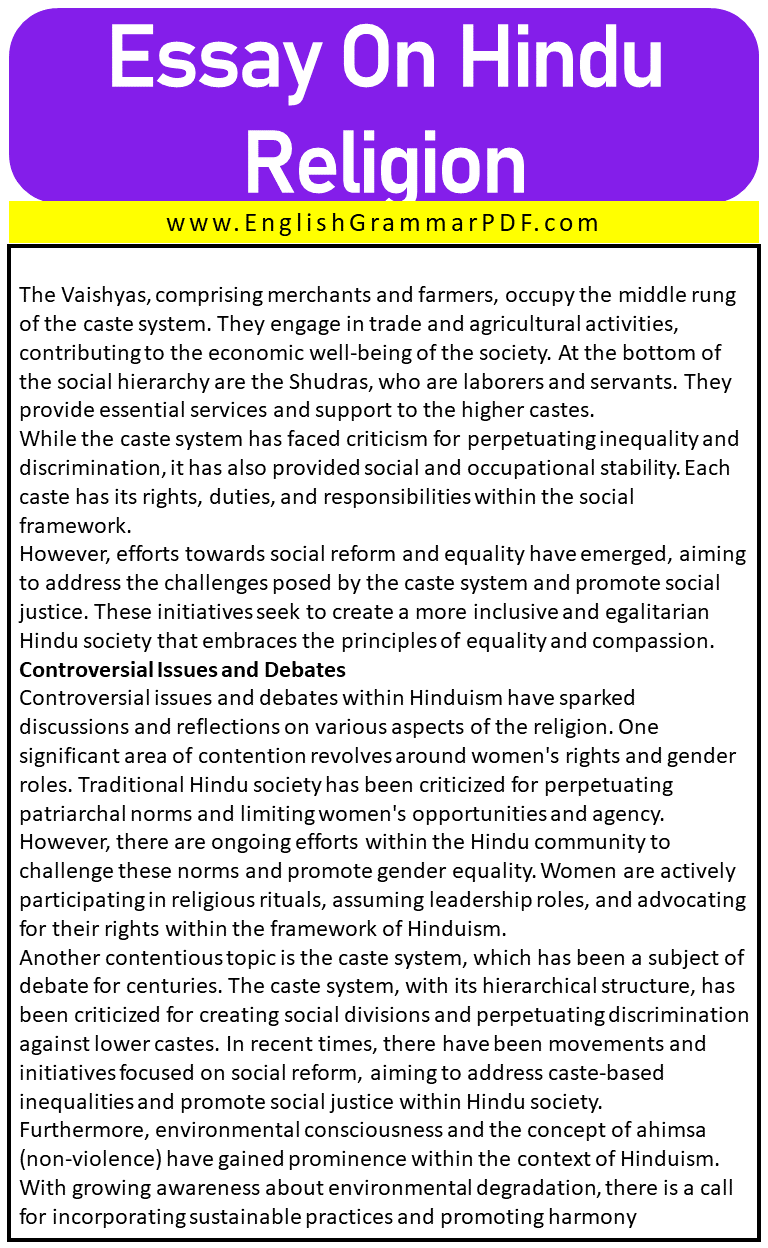Essay On Hindu Religion
Outline of Essay:
- Introduction
- Core Beliefs of Hinduism
- Deities and Divinities in Hinduism
- Rituals, Festivals, and Ceremonies
- Social Structure and Hinduism
- Controversial Issues and Debates
Introduction
Hinduism, with its complex and diverse traditions, beliefs, and practices, has had a profound influence on millions of people around the world. As one of the oldest religions in existence, Hinduism encompasses a rich tapestry of historical, philosophical, and cultural elements. It draws inspiration from various sources, including the Vedas, Upanishads, and Bhagavad Gita, which are considered sacred texts. These texts provide profound insights into metaphysical concepts, moral principles, and spiritual practices. Furthermore, Hinduism’s development was shaped by key historical events and empires, such as the Mauryan and Gupta Empires, which provided a conducive environment for the growth of the religion.
Core Beliefs of Hinduism
At the heart of Hinduism lies a set of fundamental beliefs that shape its philosophy, worldview, and spiritual practices. These core beliefs provide a foundation for understanding the nature of reality, the purpose of life, and the path to spiritual liberation.
One of the central concepts in Hinduism is Brahman, the ultimate reality that transcends the physical world. Brahman is seen as the eternal, all-pervading, and formless essence that underlies and connects everything in the universe. It is the source from which all existence arises and to which all existence ultimately returns.
Hinduism also embraces the idea of samsara, the cycle of birth, death, and rebirth. According to this belief, individuals undergo countless cycles of existence, moving through different forms of life based on their actions and karma. Karma, the law of cause and effect, states that every action has consequences, shaping one’s present and future experiences.
The ultimate goal in Hinduism is to attain moksha, liberation from the cycle of samsara, and union with the divine. Various paths, known as yogas, are available to seekers to achieve this liberation. Karma Yoga emphasizes selfless action and the performance of duties without attachment to the results. Bhakti Yoga emphasizes devotion and surrenders to a personal deity. Jnana Yoga focuses on knowledge and self-realization, while Raja Yoga emphasizes meditation and control of the mind.
Dharma, the moral and ethical duties and responsibilities, also hold a significant place in Hinduism. It encompasses righteousness, duty, and the fulfillment of social and familial obligations. Living in alignment with one’s dharma is seen as essential for personal well-being and the maintenance of social harmony.
Deities and Divinities in Hinduism
Deities and divinities play a central role in Hinduism, with a vast pantheon of gods and goddesses revered and worshipped by devotees. These divine beings are believed to possess various qualities and powers, representing different aspects of the ultimate reality, Brahman.
Major deities in Hinduism include Brahma, the creator; Vishnu, the preserver; and Shiva, the destroyer. Each of these deities is associated with specific attributes and symbols, and their stories and mythologies provide insights into profound philosophical concepts.
Goddesses hold significant positions in Hinduism as well. Lakshmi, the goddess of wealth and prosperity, Saraswati, the goddess of knowledge and arts, and Durga, the goddess of power and protection, are among the revered female divinities.
The concept of an avatar is also integral to Hindu belief. Avatars are incarnations of deities who descend to Earth to restore balance and righteousness. Lord Krishna, an avatar of Lord Vishnu, and Lord Rama, an avatar of Lord Vishnu, hold special places in Hindu mythology and are widely worshipped.
Regional variations in deity worship reflect the diverse cultural landscape of Hinduism, with local gods and goddesses occupying significant roles in different regions. The reverence and devotion towards these deities foster a deep connection between devotees and the divine, contributing to the vibrant tapestry of Hindu religious practices.
Rituals, Festivals, and Ceremonies
Rituals, festivals, and ceremonies are integral to the practice of Hinduism and play a significant role in the lives of its followers. These religious observances serve as a means of expressing devotion, connecting with the divine, and reinforcing social and cultural bonds within the community.
Hindu rituals encompass a wide range of practices, from daily personal rituals to elaborate temple ceremonies. These rituals often involve offerings of flowers, incense, and food, along with recitation of prayers and mantras. They serve as a way to communicate with the divine, seek blessings, and express gratitude.
Festivals hold a special place in Hindu culture, reflecting the diversity and vibrancy of the religion. Diwali, known as the Festival of Lights, is celebrated with great enthusiasm, symbolizing the victory of light over darkness and good over evil. Holi, the Festival of Colors, is marked by joyous gatherings where people smear each other with colored powders and water, fostering a sense of unity and celebration.
Life cycle ceremonies, including birth, marriage, and death rituals, are also significant in Hinduism. These ceremonies mark important transitions and are accompanied by specific rituals and customs that vary across different regions and communities.
Social Structure and Hinduism
The social structure of Hinduism has been shaped by the caste system, which has historical roots but has also evolved. The caste system stratifies society into distinct groups based on birth and occupation, creating a hierarchical structure that has influenced social interactions and roles.
At the top of the caste system are the Brahmins, who are traditionally priests and scholars. They hold the highest position in Hindu society and are responsible for performing religious rituals and preserving sacred knowledge. Below them are the Kshatriyas, who are traditionally warriors and rulers. They are entrusted with protecting society and governing the land.
The Vaishyas, comprising merchants and farmers, occupy the middle rung of the caste system. They engage in trade and agricultural activities, contributing to the economic well-being of the society. At the bottom of the social hierarchy are the Shudras, who are laborers and servants. They provide essential services and support to the higher castes.
While the caste system has faced criticism for perpetuating inequality and discrimination, it has also provided social and occupational stability. Each caste has its rights, duties, and responsibilities within the social framework.
However, efforts towards social reform and equality have emerged, aiming to address the challenges posed by the caste system and promote social justice. These initiatives seek to create a more inclusive and egalitarian Hindu society that embraces the principles of equality and compassion.
Controversial Issues and Debates
Controversial issues and debates within Hinduism have sparked discussions and reflections on various aspects of the religion. One significant area of contention revolves around women’s rights and gender roles. Traditional Hindu society has been criticized for perpetuating patriarchal norms and limiting women’s opportunities and agency. However, there are ongoing efforts within the Hindu community to challenge these norms and promote gender equality. Women are actively participating in religious rituals, assuming leadership roles, and advocating for their rights within the framework of Hinduism.
Another contentious topic is the caste system, which has been a subject of debate for centuries. The caste system, with its hierarchical structure, has been criticized for creating social divisions and perpetuating discrimination against lower castes. In recent times, there have been movements and initiatives focused on social reform, aiming to address caste-based inequalities and promote social justice within Hindu society.
Furthermore, environmental consciousness and the concept of ahimsa (non-violence) have gained prominence within the context of Hinduism. With growing awareness about environmental degradation, there is a call for incorporating sustainable practices and promoting harmony with nature based on the principles of ahimsa. This includes addressing issues such as pollution, deforestation, and animal welfare, as well as promoting eco-friendly celebrations of festivals.
FAQ’s
What is the Hindu religion known for?
Hinduism is known for its diverse and complex belief system, encompassing concepts such as karma, reincarnation, and the pursuit of moksha (liberation from the cycle of birth and death).
What is unique about the Hindu religion?
One unique aspect of Hinduism is its acceptance and celebration of diversity. It allows for multiple paths to spiritual realization, recognizing that individuals have different inclinations and can follow various yogic paths, such as Karma Yoga, Bhakti Yoga, Jnana Yoga, and Raja Yoga, to attain liberation.
Explore More Essays:
Download the PDF of the Essay:








